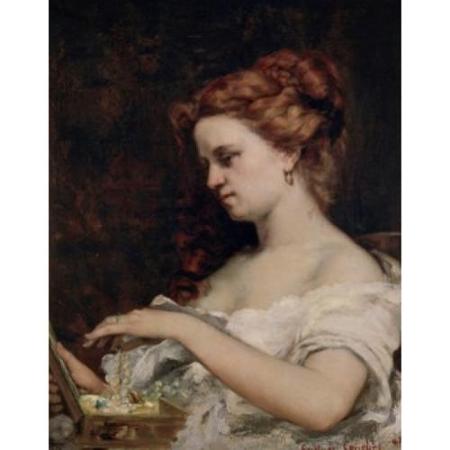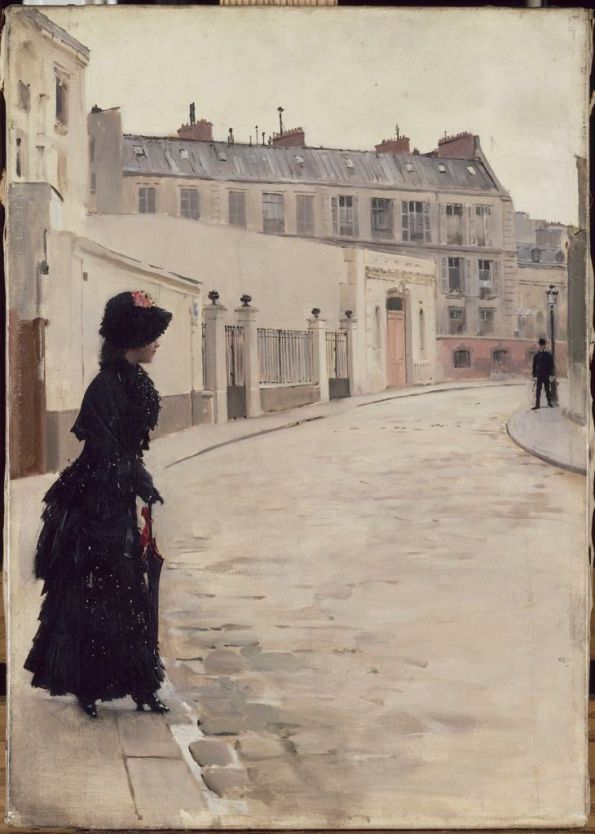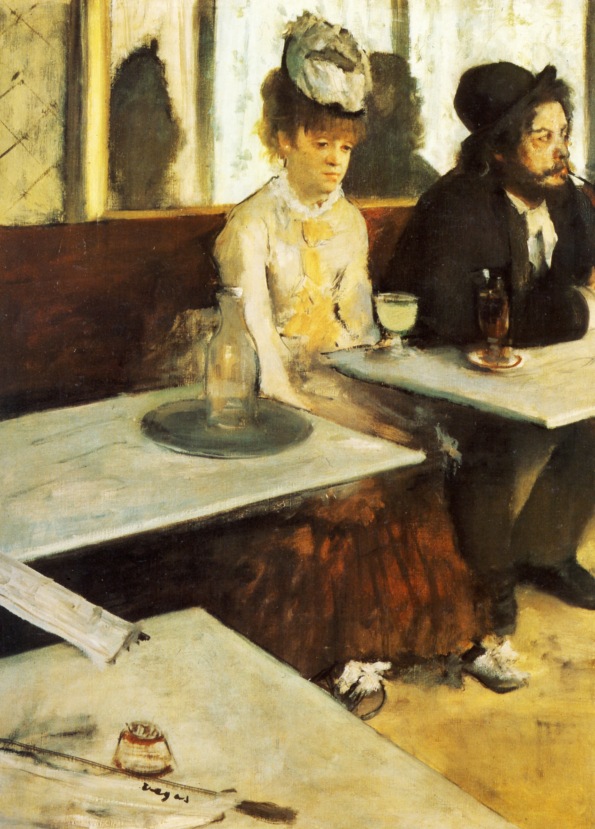Prostitution in Paris (1850-1910) Prequel of the billet about Memoirs of a cocodette written by herself by Ernest Feydeau.
I bought Souvenirs d’une cocodette, écrits par elle-même by Ernest Feydeau at the Musée d’Orsay in Paris when I attended the exhibition Splendeurs et misères. Images de la prostitution 1850-1910. A cocodette seems to be the female of a cocodes, a young Parisian from the Second Empire (1852-1870) who is only interested in showing off and being elegant. I read this short novel right away but before writing about it, I want to share with you what I learnt at this fascinating exhibition. It will help understanding the context of the Feydeau.
Splendeurs et misère was very informative about prostitution in the French society from 1850 to 1910 and how it influenced painters and writers. There were gradations in prostitution. The “happy few” if I may say, were the cocottes, the highly privileged courtesans like Nana in Zola’s novel. The painting of Blanche d’Antigny, who inspired the character of Nana was displayed.
At the time, keeping a cocotte was a proof of wealth and virility for a man. It was a social status. These women were fashionable, rich and extravagant. The papers related their parties and described their clothing.
Second rank were courtesans. Like the prostitutes living in brothels, they were listed and the police kept the records straight and implemented health controls. They had business cards that said for example “Massages hygiéniques. Massages suédois. English spoken”. English spoken? Actually, there were a lot of English aristocrats having fun in Paris at the time. Victorian etiquette wasn’t relaxing back home. Now I’m not so surprised that Odette, in Swann’s Way by Proust, peppers her sentences with English words. She’s a former cocotte and I suppose Proust did it on purpose.
Third rank were prostitutes in brothels. That part was mostly illustrated with paintings by Henri de Toulouse-Lautrec.
He did series of paintings in famous maisons closes and he was friends with a lot of prostitutes. He painted them in their everyday life. Relaxing, having a bath, chatting, waiting on customers. We also had the chance to see the Prince of Wales’s custom-made love seat.
It stayed in his favourite Parisian brothel and was designed to accommodate his heavy body and allow threesomes. When you think of the hard time the current Prince of Wales was given for his long term mistress…
And then there were the others, women who had jobs that didn’t pay enough and resorted to prostitution to feed the children. They were linen maids or sales clerks. As linen maids, they had the opportunity to enter houses. (Keep that in mind for next billet) and as sales clerks, they were put on display behind the shop’s window and men had the chance to approach them. Now think about Gissing’s novel, The Odd Women and Monica who works at a shop and becomes Edmund’s wife…The implications of working in a shop ring differently.
The theatre and the opera were also an opportunity for men to meet women and for women to find a protector or at least customers. The bal of the opea was famous for that and even on normal nights, available women were lingering in the stairs and in the hallways to catch a suitor.
It was explained that dancers of the opera Garnier were fair game for the men who had a subscription at the opera. They had the right to visit the dancers after the shows and hit on them. The dancers were willing to find a protector to leave misery behind. It gives another perspective on Degas’s series of paintings about dancers, no?
Available women waited on the streets or could be seen on the boulevards at nightfall. This is why they are called Belles de nuit (night beauties) in French.
Gas lamppost revolutionized prostitution as the women were able to better show off their assets. To attract customers, they would lift their dresses a bit to show an ankle or show off their derriere.
The other ways to find a prostitute was to go to a café. It was not appropriate for women to stay in a café without a chaperone. So, when a woman was sitting there, drinking alcohol, she sent the message that she was available for paid sex. Like here in Degas’s paintings:
I wonder about Albertine, from In Search of Lost Time. Her freedom had always seemed odd to me. But now, I’m pretty sure she was selling her charms. She moved in with the Narrator and she was spending time in cafés with her girlfriends.
The law regarding selling alcohol was changed during the Second Empire. It resulted in the development of specialized cafés where women made themselves available for paid sex. They called themselves The Bees or other nicknames and recruited waitresses. They were solid competition for the women in brothels who were monitored by the police.
The exhibition made the link between painting and literature, quoting Balzac (Splendeurs et misère des courtisanes), Zola (Nana), Baudelaire, Dumas (La dame aux camélias)
This fascinating exhibitions showed that new inventions like photography and cinema were quickly used for pornography. A “red room” showed the visitors that our century has nothing to teach to the 19thC in that matter.
It also showed the miserable side of prostitution and the ravages of syphilis. There is no testimony from women. All we have is seen through the men’s eyes. I bet it’s not as ugly as it felt for the women.
Honestly, I didn’t know that prostitution had infiltrated society that way. It seems like it was everywhere and a component of it. It was, let’s say, a fact of life. It was extremely informative and it gave me another perspective on the paintings and literature of the time.











Thanks for presenting this excellent overview on prostitution and bringing it to life with terrific images. In defining the ‘ranks” you’ve helped me put the multiple prostitutes I recall from my reading in perspective.
LikeLike
Hi David,
I’m glad you find it useful. It was to me and I wanted to share with other readers.
LikeLike
To think we’ve come such a long way…now we can enjoy the cafes and the wine without the 19th century implication.
LikeLike
Yes, true. And of course, we also have Financial help for single mothers. (at least in France we do)
LikeLike
I read a non fiction book about prostitutes in Sf’s Chinatown. The conditions were appalling.
LikeLike
I’m sure the conditions weren’t stellar in those brothels either. Napoleon (the 1st) passed the law to have the prostitutes listed and checked up. That’s all. The follow up was done regularly, from the documents I’ve seen at the exhibition.
Still. It’s miserable to have to sell one’s body for a living.
LikeLike
Some of them were kept in cribs and basically used until they died–which didn’t take long.
LikeLike
How awful. Nothing like this was mentioned here, not that it was all hearts and flowers either. I suppose the monitoring of the police helped? (if they weren’t corrupt) Or they kept silent on the worst part.
Btw, I’ve seen some of the porn photos they made at the time. It reminded me of The Romance of a Shop and the anxiety Gertrude had when she needed to go to new places. She didn’t always know exactly what kind of photography was expected.
LikeLike
Yes those old dirty photos would not make it to Hustler..
LikeLike
It sounds like a fascinating exhibition, Emma. Thank you for writing about this – I feel as though I’ve learnt something here. It’s interesting (and sad) to hear about the different ranks in the hierachy..
LikeLike
Thanks Jacqui
I wanted to share about this exhibition because it has a direct link with literature.
LikeLike
Fascinating, Emma. I drifted off reading about Blanche d’Antigny, didn’t know who she was, and i enjoyed reading your billet and looking forward to the next one. That said, you ruined some of the models in those impressionist paintings :-), particularly in Degas’. In L’Absinthe, for example, I always imagined this was a woman unhappy in her marriage, but I think it makes more sense to think of them as prostitutes since, (I assume) the impressionists weren’t so concerned with content as much as with form and reality. I’m glad things are different for actresses and singers these days though I suppose some aspects of the immorality of the entertainment industry of the 19th century remain to this day.
LikeLike
I know, you see impressionist paintings differently after that. Especially the dancers by Degas. About L’absinthe: maybe you’re right, this woman might have a terrible husband who drinks all the money and she needs to provide for the children. 🙂
I think the Impressionists painted about they surroundings and they were part of the Parisian life. So the prostitutes were part of it.
While I was writing this billet, I wasn’t thinking about today’s actresses and singers. These women made me think of these celebrities from trash TV. They’re ready to sell their image for a little fame or to get out of their environment, trying to climb the social ladder with their bodies.
LikeLiked by 1 person
I did not attend this exhibit because I have strong feelings about the glamorization of women as Whores .or Madonnas for that matter, but I certainly enjoyed your comments and painting selections. (I had trouble accepting this as a subject for an exhibition at the Orsay.).
Roughly at the same time, I watched the movie titled below, which gave, perhaps, a more accurate view of the anything but glamorous life in a brothel.
Bertrand Bonello’s House of Pleasures (a.k.a. House of Tolerance and L’Apollonide: souvenirs de la maison close)
Another movie on the topic is Bolognin’s Bubu de Montparnasse
I don’t know if either is available for viewing on US DVD players .
LikeLike
Believe me, there was no glamorization of women as whores. At all. The title of the exhibition is Splendeurs et misère. The misery part is also present in the comments and the paintings by Toulouse-Lautrec aren’t glamorous.
I am glad that the Musée d’Orsay did this exhibition. It was part of the 19thC and they have to show all the aspects, even the bleak ones. Not to show it equals putting the subject under the carpet, like it never existed. It’s a way to be reminded of our history and like Delia mentioned in her comment, it shows how we moved on.
I haven’t seen these films but I’ve heard about them.
LikeLike
I did not attend this exhibit because I have strong feelings about the glamorization of women as Whores .or Madonnas for that matter, but I certainly enjoyed your comments and painting selections. (I had trouble accepting this as a subject for an exhibition at the Orsay.).
Roughly at the same time, I watched the movie titled below, which gave, perhaps, a more accurate view of the anything but glamorous life in a brothel.
Bertrand Bonello’s House of Pleasures (a.k.a. House of Tolerance and L’Apollonide: souvenirs de la maison close)
Another movie on the topic is Bolognin’s Bubu de Montparnasse
I don’t know if either is available for viewing on US DVD players .
LikeLike
I assume that “Romy Paris” and “Jane Stivarius” are the same person with a differen account?
LikeLike
Sorry for the double post . . .I hit the button too fast. I agree with what you said about the need to present the topic, However I would disagree with the idea that prostitution in the Belle Epoque has ever been swept under the carpet. What is swept under the carpet is syphilis rampant in France during that period, women working at starvation wages so a side job was necessary to keep alive, the ruination of family wealth. . . .the misere. Somehow,from what friends who saw it said, I don’t think the misere aspect formed a major part of this exhibit.
Have we really moved on? To me, the only thing that has really changed is the use of effective drugs in the treatment of VD. For many reasons, women are still forced or being forced to sell themselves.
LikeLike
It’s not a major part of the exhibit but it’s written right from the start that the only witnesses who left images of prostitution were men. There’s nothing to show from the women’s point of view, sadly, because these women had no voice.
There is a part about syphilis in the exhibition (and pictures of what the disease did to people) I don’t think this aspect is swept under the carpet: we all know that it was rampant. Maupassant died of syphilis.
For me, this also showed how French men of that time objectified women. They are really condescending and treating women like dirt. IMO, French literature of the Belle Epoque is more sexist that British literature at the same time. (I’m thinking about Gissing or Trollope’s Miss McKenzie) Really, in French books women are beautiful, manipulative, emotive. They faint, they play games, they are seductresses or silly (Madame Bovary) Even in Zola’s books. I haven’t read everything of course, but I haven’t read a single French book of the time with an intelligent woman or one who fights for being equal to men. No Wonder why it took us so long to have the right to vote.
LikeLike
not only Maupassant . . .Manet, the Goncourt brothers, Daudet, Baudelaire, Stendahl, Flaubert, Jacquemart of the museum, Dumas Pere et fils, Lautrec, van Gogh. . . .to name only a stellar few in the French art/literary community. (Your Gissing too)
I agree about the French novelists but Balzac does try for a more balanced approach in Lily of the Valley to mention just one of his . . .and Zola in Cousin Betty.
LikeLike
Given the number of paintings available about prostutition or featuring prostitutes, it’s not surprising.
I agree about Balzac: Mémoires de deux jeunes mariées takes into account a woman’s perspective. I don’t think there is any “feminist” side in La cousine Bette. Women are stereotype.
LikeLike
Oops, Balzac’s Cousin Betty
LikeLike
Absolutely fascinating. The shopgirl point shows how we can read period novels and yet fail to pick up subtexts that would have been absolutely obvious to contemporary readers. I’d have assumed being a shopgirl was shameful because it was trade, but I’d have missed the implication of possible prostitution and failing that of being inappropriately (for the period) accessible to men.
In Jean Rhys’s novels her protagonists find that being a woman sitting alone in a cafe in the 1920s leads to cold glances and unwanted attention. That fits too, because only 30 years previously it would have been a sign of prostitution. No wonder the older cafe owners are so hostile, that’s within their lifetimes and what they’d have been brought up with.
LikeLike
That’s exactly how I felt about this exhibit. It gives pointers to better understand paintings and literature.
Like you, I thought that the problem about being a shopgirl was linked to it being trade.
Good remark about Jean Rhys. I guess women conquering cafés without it being degrading is a Victory I never knew about.
What do you think about Proust? Does it give you another view of some characters?
LikeLike
Absolutely. The whole thing’s hugely helpful. I wish I’d seen the exhibition.
LikeLike
I skipped this exhibit at Orsay in favor of the other one (on female photographers), but your description of the exhibit’s exploration of certain elements in paintings (and of your own illuminations in literature) makes it sound quite a bit more interesting than I would have thought. I’m really struck by that Bertaud painting above; dirty up the street a bit, modernize the clothing and make it shabbier, make the woman an African immigrant, and presto: you have the area around Chateau Rouge metro station today. Plus ça change…
Your comment that the record of prostitution of the time comes almost exclusively from men speaks volumes. A couple of years ago I read Paul Léautaud’s The Child of Montmartre, which tells of his upbringing (and subsequent adulthood) among the city’s prostitutes, but typically it glosses over the difficulties faced by many of these women.
LikeLike
I’ve seen Qui a peur des femmes photographes too. Have you been at the Orangerie for the first part of the exhibit? This part was better than the one at Orsay, which I found disappointing.
There is nothing said from the women’s point of view. And when you think about it, the photos taken by women photographers of the time stay far from social issues.
It’s like the French women of that century had no voice. Take British literature: you have Mary Shelley, the Brontë sisters, George Eliot, Christina Rossetti, Elizabeth Gaskell, ME Braddon… Where are their French counterparts? Poor George Sand is lonely.
So it’s not surprising that this exhibit showed nothing from a woman’s point of view. (not a single painting by Berthe Morisot, for example)
LikeLike